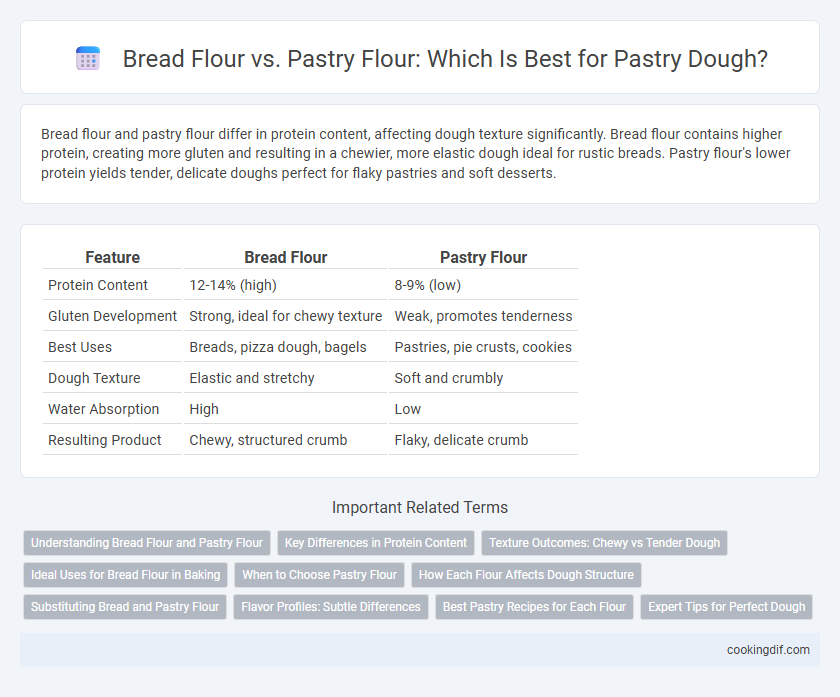Bread flour and pastry flour differ in protein content, affecting dough texture significantly. Bread flour contains higher protein, creating more gluten and resulting in a chewier, more elastic dough ideal for rustic breads. Pastry flour's lower protein yields tender, delicate doughs perfect for flaky pastries and soft desserts.
Table of Comparison
| Feature | Bread Flour | Pastry Flour |
|---|---|---|
| Protein Content | 12-14% (high) | 8-9% (low) |
| Gluten Development | Strong, ideal for chewy texture | Weak, promotes tenderness |
| Best Uses | Breads, pizza dough, bagels | Pastries, pie crusts, cookies |
| Dough Texture | Elastic and stretchy | Soft and crumbly |
| Water Absorption | High | Low |
| Resulting Product | Chewy, structured crumb | Flaky, delicate crumb |
Understanding Bread Flour and Pastry Flour
Bread flour contains a higher protein content, typically 12-14%, which promotes strong gluten development essential for chewy, elastic dough ideal for breads. Pastry flour has a lower protein level, around 8-9%, producing tender, delicate baked goods by limiting gluten formation. Choosing the appropriate flour type directly impacts the texture and structure of dough, making bread flour suitable for hearty loaves and pastry flour optimal for soft, flaky pastries.
Key Differences in Protein Content
Bread flour contains approximately 12-14% protein, resulting in higher gluten development that provides dough with greater elasticity and strength, ideal for chewy, well-structured baked goods. Pastry flour, with a lower protein content around 8-9%, produces tender, flaky textures by limiting gluten formation, making it perfect for delicate pastries and pie crusts. Choosing between bread flour and pastry flour directly impacts dough consistency, rise, and final product texture due to these key differences in protein content.
Texture Outcomes: Chewy vs Tender Dough
Bread flour, high in protein (12-14%), develops strong gluten strands, resulting in a chewy, elastic dough ideal for hearty breads. Pastry flour contains less protein (7-9%), producing a softer, tender crumb with a delicate texture suited for pastries and tender baked goods. Choosing bread flour yields a dense, resilient structure, while pastry flour promotes a light, flaky consistency in dough.
Ideal Uses for Bread Flour in Baking
Bread flour contains higher protein content, typically 12-14%, which promotes strong gluten development necessary for chewy, structured baked goods like artisan bread, pizza dough, and bagels. Its elasticity and firmness make it ideal for recipes requiring a sturdy yet flexible dough capable of trapping gases for a good rise and crust formation. Using bread flour in baking results in a sturdy crumb and crisp crust, perfect for yeast-leavened products demanding volume and texture.
When to Choose Pastry Flour
Pastry flour is ideal for recipes requiring a tender, flaky texture such as pie crusts, cookies, and certain cakes due to its lower protein content (8-9%) compared to bread flour (12-14%). Unlike bread flour, which develops strong gluten strands perfect for chewy, elastic doughs like in bread, pastry flour produces less gluten, resulting in a softer, crumbly finish. Choose pastry flour when the goal is to achieve delicate pastries where tenderness and lightness are key.
How Each Flour Affects Dough Structure
Bread flour, with its higher protein content of around 12-14%, develops more gluten, resulting in a stronger, chewier dough structure ideal for artisan loaves and pizza crusts. Pastry flour contains less protein, typically 8-9%, producing a tender, delicate crumb by limiting gluten formation, which is perfect for flaky pastries and soft cakes. Choosing the right flour affects dough elasticity, rise, and final texture, ensuring the baked product meets specific textural and structural goals.
Substituting Bread and Pastry Flour
Bread flour has a higher protein content, typically 12-14%, which develops more gluten and creates a chewier, denser texture ideal for artisan bread and pizza dough. Pastry flour contains less protein, around 8-9%, resulting in a tender, crumbly texture perfect for delicate pastries and pie crusts. When substituting bread flour for pastry flour, reduce kneading time and consider adding a bit of fat to maintain tenderness; replacing bread flour with pastry flour in bread recipes may yield softer, less structured loaves that lack the desired chewiness.
Flavor Profiles: Subtle Differences
Bread flour, with its higher protein content around 12-14%, leads to more gluten development, resulting in chewier textures and a slightly nutty, robust flavor in dough. Pastry flour contains less protein, approximately 8-9%, which produces tender, flaky baked goods with a delicate, milder taste that highlights subtle buttery and sweet notes. Choosing between bread flour and pastry flour influences the dough's flavor profile by balancing chewiness and tenderness with nuanced flavor intensity.
Best Pastry Recipes for Each Flour
Bread flour, with its high protein content of around 12-14%, creates strong gluten networks ideal for chewy, structured doughs like artisan breads and pizza crusts. Pastry flour, containing 8-9% protein, produces tender, delicate textures perfect for flaky pastries, pie crusts, and biscuits. For the best pastry recipes, use bread flour in rustic breads and enriched doughs, while pastry flour excels in cakes and cookies where a soft crumb is desired.
Expert Tips for Perfect Dough
Bread flour, with its high protein content (12-14%), develops more gluten, providing elasticity and structure ideal for chewy doughs like artisan bread. Pastry flour, lower in protein (8-9%), produces tender, flaky textures perfect for delicate pastries and pie crusts by minimizing gluten formation. Expert tips recommend selecting flour based on desired dough texture: choose bread flour for sturdy, airy loaves and pastry flour for soft, crumbly baked goods.
Bread flour vs Pastry flour for dough Infographic

 cookingdif.com
cookingdif.com